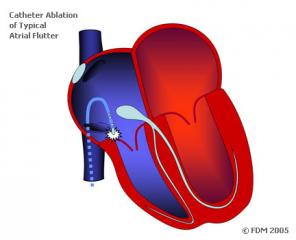

A total of 798 (55.0%) had been treated with class I or III antiarrhythmic drugs before ablation. Results Overall, 1450 patients (1034 male 1397 White) underwent catheter ablation for persistent AF, including 949 at Mercy Health (186 CF-I6 and 763 CF-I56 mean age, 64.9 years) and 501 at Mayo Clinic (337 CF-I6 and 164 CF-I56 mean age, 63.7 years). Risk differences were estimated between catheter groups and averaged across the 2 health care systems, testing for noninferiority of the CF-I6 vs the CF-I56 catheter with respect to the safety outcome using 2-sided 90% CIs. Propensity score weighting was used to balance baseline covariates. The exploratory effectiveness outcome was a composite of AF-related hospitalization events after a 90-day blanking period. Main Outcomes and Measures The primary safety outcome was a composite of death, thromboembolic events, and procedural complications within 7 to 90 days. Objective To use health system data to compare the safety and effectiveness of the CF-I6 catheter for persistent AF ablation with the ThermoCool SmartTouch SurroundFlow catheter (ablation catheter with contact force and 56-hole irrigation ), which is approved by the FDA for this indication.ĭesign, Setting, and Participants This retrospective, comparative-effectiveness cohort study included patients undergoing catheter ablation for persistent AF at Mercy Health or Mayo Clinic from January 1, 2014, to April 30, 2021, with up to a 1-year follow-up using electronic health record data.Įxposures Use of the CF-I6 or CF-I56 catheter. There is a need to understand whether data from routine clinical practice can be used to conduct regulatory-grade evaluations and support label expansions. Importance The ThermoCool SmartTouch catheter (ablation catheter with contact force and 6-hole irrigation ) is approved by the US Food and Drug Administration (FDA) for paroxysmal atrial fibrillation (AF) ablation and used in routine clinical practice for persistent AF ablation, although clinical outcomes for this indication are unknown. Shared Decision Making and Communication.Scientific Discovery and the Future of Medicine.Health Care Economics, Insurance, Payment.Clinical Implications of Basic Neuroscience.Challenges in Clinical Electrocardiography.Cumulative Incidence of Exploratory Effectiveness Outcome at 365 Days Among Covariate-Balanced Data at Mayo Clinic Cumulative Incidence of Exploratory Effectiveness Outcome at 365 Days Among Covariate-Balanced Data at MercyĮFigure 4. Cumulative Incidence of Primary Safety Outcome Among Covariate-Balanced Data at Mayo ClinicĮFigure 3. Cumulative Incidence of Primary Safety Outcome Among Covariate-Balanced Data at MercyĮFigure 2. Cumulative Incidences and Risk Differences of the Primary Composite Safety Outcome Among Patients Undergoing Ablation for Persistent Atrial Fibrillation With a Prior Prescription of Class I or III Anti-arrhythmic Drug Within the 6 Months Before the Index Ablation Using Propensity Score Balanced DataĮFigure 1. Cumulative Incidences and Risk Differences of the Primary Composite Safety Outcome Among Patients Undergoing Ablation for Persistent Atrial Fibrillation Using Propensity Score Balanced Data With Exclusion of Hospital Bed Size From the Propensity Score Model in the Mayo Clinic DatabaseĮTable 6. Summary of Charts Reviewed for Safety OutcomeĮTable 5. Absolute Standardized Differences (ASDs) According to Unadjusted (Crude) Data and Different Propensity Score Methods Among Patients Undergoing Ablation for Persistent Atrial Fibrillation in the Mayo Clinic DatabaseĮTable 4. Absolute Standardized Differences (ASDs) According to Unadjusted (Crude) Data and Different Propensity Score Methods Among Patients Undergoing Ablation for Persistent Atrial Fibrillation in the Mercy DatabaseĮTable 3. Patient Follow-up 365 Days After Index Catheter Ablation With a Catheter with Contact Force and 6-hole Irrigation or a Catheter with Contact Force and 56-hole IrrigationĮTable 2.


 0 kommentar(er)
0 kommentar(er)
